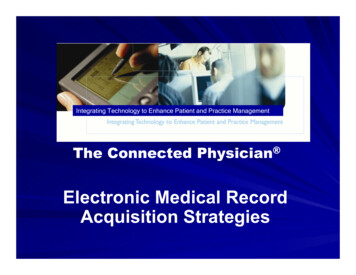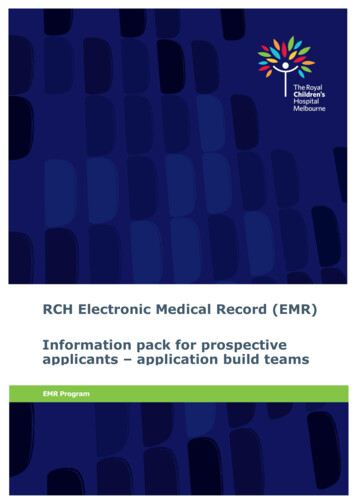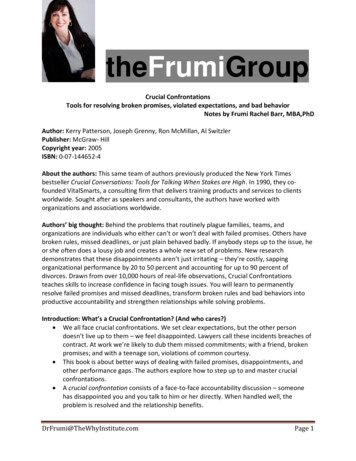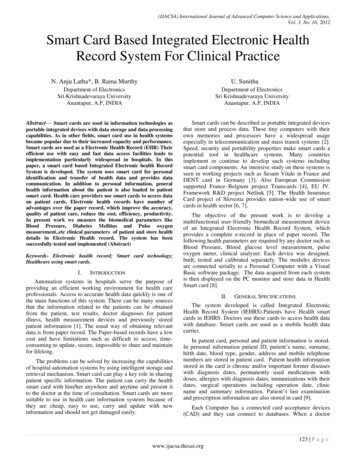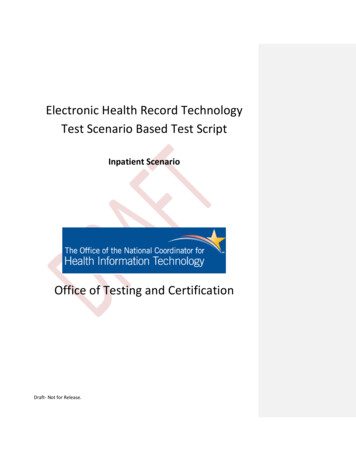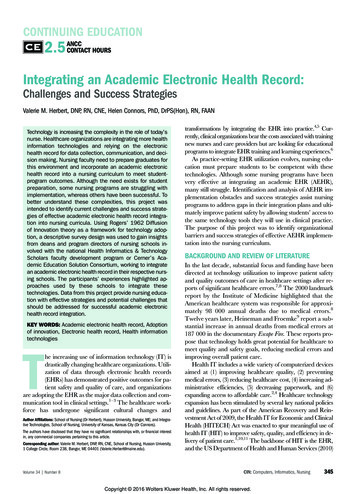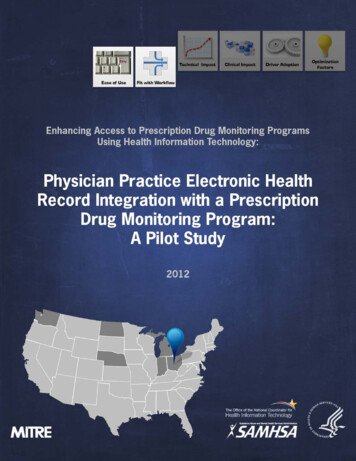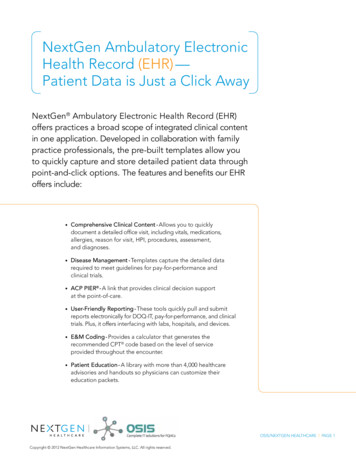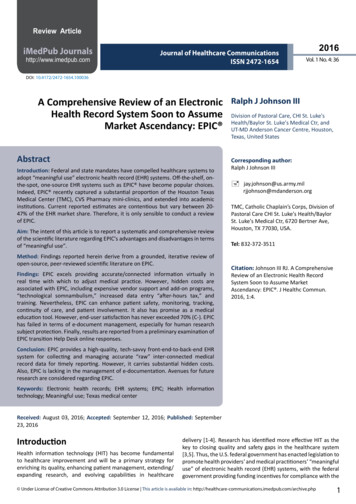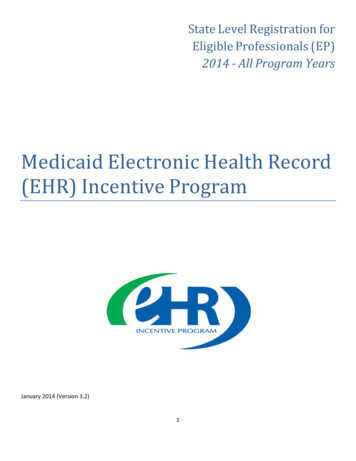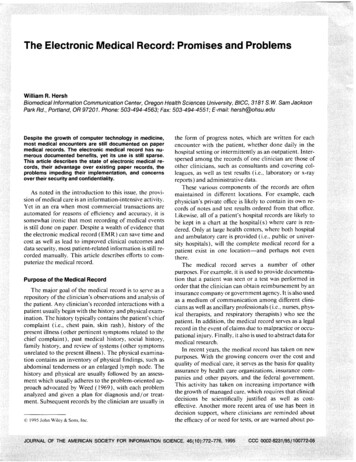
Transcription
The Electronic Medical Record: Promises and ProblemsWilliam R. HershBiomedical Information Communication Center, Oregon Health Sciences University, BICC, 3 18 1 S. W. Sam JacksonPark Rd., Portland, OR 97201. Phone: 503-494-4563; Fax: 503-494-4551; E-mail: hersh@ohsu.eduDespite the growth of computer technology in medicine,most medical encounters are still documentedon papermedical records. The electronic medical record has numerous documentedbenefits, yet its use is still sparse.This article describes the state of electronic medical records, their advantage over existing paper records, theproblems impeding their implementation,and concernsover their security and confidentiality.As noted in the introduction to this issue, the provision of medical care is an information-intensiveactivity.Yet in an era when most commercial transactions areautomated for reasons of efficiency and accuracy, it issomewhat ironic that most recording of medical eventsis still done on paper. Despite a wealth of evidence thatthe electronic medical record (EMR) can save time andcost as well as lead to improved clinical outcomes anddata security, most patient-related information is still recorded manually. This article describes efforts to computerize the medical record.Purpose of the Medical RecordThe major goal of the medical record is to serve as arepository of the clinician’s observations and analysis ofthe patient. Any clinician’s recorded interactions with apatient usually begin with the history and physical examination. The history typically contains the patient’s chiefcomplaint (i.e., chest pain, skin rash), history of thepresent illness (other pertinent symptoms related to thechief complaint),past medical history, social history,family history, and review of systems (other symptomsunrelated to the present illness). The physical examination contains an inventory of physical findings, such asabdominal tenderness or an enlarged lymph node. Thehistory and physical are usually followed by an assessment which usually adheres to the problem-oriented approach advocated by Weed ( 1969), with each problemanalyzed and given a plan for diagnosis and/or treatment. Subsequent records by the clinician are usually inG 1995 John Wiley & Sons. Inc.the form of progress notes, which are written for eachencounter with the patient, whether done daily in thehospital setting or intermittently as an outpatient. Interspersed among the records of one clinician are those ofother clinicians. such as consultants and covering colleagues, as well as test results (i.e., laboratory or x-rayreports) and administrative data.These various components of the records are oftenmaintained in different locations. For example, eachphysician’s private office is likely to contain its own records of notes and test results ordered from that office.Likewise, all of a patient’s hospital records are likely tobe kept in a chart at the hospital(s) where care is rendered. Only at large health centers, where both hospitaland ambulatory care is provided (i.e., public or university hospitals), will the complete medical record for apatient exist in one location-andperhaps not eventhere.The medical record serves a number of otherpurposes. For example, it is used to provide documentation that a patient was seen or a test was performed inorder that the clinician can obtain reimbursement by aninsurance company or government agency. It is also usedas a medium of communicationamong different clinicians as well as ancillary professionals (i.e., nurses, physical therapists, and respiratory therapists) who see thepatient. In addition, the medical record serves as a legalrecord in the event of claims due to malpractice or occupational injury. Finally, it also is used to abstract data formedical research.In recent years, the medical record has taken on newpurposes. With the growing concern over the cost andquality of medical care, it serves as the basis for qualityassurance by health care organizations, insurance companies and other payors, and the federal government.This activity has taken on increasing importance withthe growth of managed care, which requires that clinicaldecisions be scientifically justified as well as costeffective. Another more recent area of use has been indecision support, where clinicians are reminded aboutthe efficacy of or need for tests, or are warned about po-
tential drug interactions. All of these newer purposes aregreatly enhanced by the EMR.The Paper-BasedMedical RecordDespite the documented benefits of the EMR, mostclinical encounters are still recorded by hand in a paperrecord. This is not without reason. Dick and Steen( 199 1) note that the traditional paper record is still useddue to its familiarity to users, portability, ease of recording “soft” or “subjective” findings, and its browsabilityfor non-complex patients. There is also a sense of ownership of paper records, due to their being only one copy,which increases the sense of their security (although itwill be noted below that this may be a false sense ofsecurity).Nonetheless, there are many problems with paperbased medical records. The first is that the record canonly be used in one place at one time. This is a problemfor patients with complex medical problems, who interact with numerous specialists, nurses, physical therapists, etc. Another problem is that paper records can bevery disorganized. Not only can they be fragmentedacross different physician offices and hospitals, as notedabove, but the record at each location itself can often bedisorganized, with little overall summary. In most paperrecords, pages are added to the record as they are generated chronologically, making the viewing of summarizeddata over time quite difficult.Another problem with the paper record is incompleteness. In an analysis of U.S. Army outpatient clinics, Tufoand Speidel ( 197 1) found as many as 20% of charts hadmissing information, such as laboratory data and radiology reports, a finding consistent with more recent observations ( Korpman & Lincoln, 1988; Romm & Putnam,1981).A final problem with the paper-based record is security and confidentiality. Although usually ascribed as aproblem of the EMR, there are attributes of the paperrecord that increase its vulnerability to access by nonprivileged outsiders. Its difficulty in duplication leads toa great deal of photocopying and faxing among providersand institutions. Furthermore, abstractions of the paperrecord are stored in large databases, such as those of theMedical Information Bureau, which are maintained byhealth insurance companies to prevent fraud but containmedical information of more than 12 million Americans( Rothfeder, 1992).AdditionalChallengesfor the New Health Care EraThe problems of the paper-based record listed aboveare magnified in this new era of health care fueled bymanaged care. Managed care systems, typified by healthmaintenance organizations ( HMO’s), act as both healthcare insurer and provider. The traditional indemnity insurer operates in a fee-for-service environment where theproviders are reimbursed based on charges billed. Themanaged care organization, on the other hand, is provided a fixed fee per patient, which gives it the incentiveto keep patients healthy and provide care costeffectively. The benefits and drawbacks of managed careare beyond the scope of this article, but suffice it to saythat managed care will play an increasingly larger rolein the provision of American health care, and successfulmanaged care organizations require cost efficiency,which in turn requires effective management of information.There are many areas where improved informationmanagement can aid managed care organizations. Forexample, because many of these organizations providecomprehensive health care for their subscribers, theyneed effective communication between different providers, ancillary staff, and/or hospitals. Likewise, they needto determine whether those groups are providing costeffective care and not ordering excessive laboratory tests,x-rays, etc. Finally, these organizations often try to control the use of expensive medications and substitute theiruse with cheaper but equally effective ones.Even outside the context of managed care, the efficiencies in communication and cost will be desired bysociety in general as the cost of health care continues toconsume larger proportions of the gross domestic product. All payors, even traditional fee-for-service insurancecompanies, are beginning to require it.Implementationsof the ElectronicMedical RecordAlthough the complete EMR does not currently exist,portions of the medical record have been computerizedfor many years. The most heavily computerized aspectsare the administrative and financial portions. On theclinical side, the most common computerized functionhas been the reporting of laboratory results, usuallymade easier with the installation of automated equipment for laboratory specimen testing. As more information recording functions become computerized (i.e., clinician dictations transcribed into word processingsystems), increasing proportions of the record are computerized as well.Dick and Steen note that all comprehensive EMR’sshare several common traits ( Dick & Steen, 199 1). First,they all contain large data dictionaries that define theircontents. Second, all data are stamped with time anddate so that the record becomes a permanent chronological history of the patient’s care. Third, the systems havethe capability to display data in flexible ways, such asflowsheets and graphical views. Finally, they have aquery tool for research and other purposes.A number of successful EMR implementations havebeen in place for decades. One of the earliest ambulatorycare record systems was COSTAR (Computer-StoredAmbulatory Record), developed at Massachusetts Gemeral Hospital in Boston ( Barnett et al., 1979). It allows
patient registration and scheduling, storage and retrievalof clinical data, and financial capabilities such as billing.The core COSTAR system is in the public domain sothat other vendors and institutions can modify and enhance it. Another well-known ambulatory system is theRegenstrief Medical Record System at Indiana University (McDonald,Blevins, Tierney, & Martin, 1988) which implements similar functions but is also wellknown for its capacity for physician decision support(see below).There have also been a number of long-standing EMRsystems for hospitals. The HELP (Health Evaluationthrough Logical Processing) system was developed at theUniversity of Utah and Latter-Day Saints (LDS) Hospital in Salt Lake City (Warner, Olmsted, & Rutherford,1972). Similar to the Regenstrief system, it attempts toactively assist physician decision-making by providingalerts of potentially problematic situations and reminders for routine care.Most of the above systems, as well as newer ones, haveevolved with computer and network technology itself.Most systems initially consisted of dumb terminals connected to mainframes or minicomputers, but have sinceevolved into microcomputer-based networks embracingclient-server architectures. Future technologies, such asvoice recognition or pen-based input, will likely causefurther evolution of these systems.Benefits of the ElectronicMedical RecordThere are many potential benefits ofthe EMR. Unlikethe paper record, it can potentially be used by anyonewho needs it at any time. It can also be accessed easilyfrom remote sites. such as a clinic across town or evenacross the country. It is unlikely that data will be lost ormisplaced. With an appropriate back-up mechanism, itshould serve as a permanent record of an individual’sinteraction with the health care system. Furthermore,with the availability of all the patient’s data, new viewsand other summaries can be generated instantaneously.Finally, with the potential for the incorporation of reminders and decision support, the likelihood of mistakesand omissions should decrease.In addition to benefiting the individual patient, theEMR is also likely to benefit the larger population. Clinical research will likely be enhanced, as researchers haveeasier access to information about patients that will increase understanding of disease and its treatment.Screening and other preventive measures will becomeeasier to implement as patients of various attributes (i.e.,gender, age, presence of other risk factors) can be identified and contacted.A number of studies have documented some of thebenefits of the EMR. The most comprehensive work inthis area has come from Indiana University, where theRegenstrief computerized medical record system hasbeen developed over the last two decades. An initial clin-ical focus of the system was on reminders for cliniciansto perform various actions (such as ordering a test or prescribing as therapy) based on rules they had themselvesgenerated. Examples included the recommendation toorder a routine mammogram or check the serum potassium level of a patient on diuretic medication. A randomized controlled trial showed that physicians whowere given these reminders were more likely to complywith these measures that had been deemed important byphysicians themselves (McDonald,Hui, & Smith,1984).Most of the documented benefits of the EMR haveemerged from settings where clinicians use the systemhighly interactively as opposed to a passive replacementfor the paper record. This requires that clinicians use thesystem for order entry. where orders for tests and medications are entered directly by the clinician. In anotherstudy at Indiana University, Tierney, Miller, Overhage,& McDonald ( 1993) performed a randomized controlled trial of a complete order entry system that included innovations such as displaying the cost of the testor medication. showing a list of pending tests, and directly linking with an online drug reference manual.Those randomized to use the system were found to generate 12.7% less charges without compromise in patientcare. Their patients also spent nearly one day less in thehospital. The authors estimated that implementing thissystem hospital-wide could save as much as 300,000.Another site of studies documenting the benefits ofthe EMR has been Brigham and Women’s Hospital(BWH) in Boston. Cost savings in several areas havebeen documented due to display of less expensive butequally efficacious alternatives. For example, the medication accounting for the largest cost of any single medication in this hospital is the drug odansetron, used tocontrol nausea in cancer chemotherapy patients. By programming the order entry system to use as a default anequally effective but less costly dose, the hospital was ableto save 100,000 over a one-year period (Bates, Kuperman. & Teich, 1994). The hospital is currently modifying its order entry system to remind physicians of testsordered too frequently, such as a serum theophyllinelevel ordered within 24 hours of a previous one (DavidW. Bates, personal communication).An additional measure to save costs has been the useof algorithms to assist decision-making. While comprehensive expert systems such as QMR (Miller, Masarie,& Myers, 1986) are too time-consuming and complexfor everyday use, focused decision support has beenshown to be effective. At Brigham and Women’s Hospital, an algorithm to determine the probability of chestpain being due to myocardial infarction (and hence assist with the decision to admit a patient to the hospital)has been shown to perform more accurately than physicians (Lee et al., 199 1). This allows patients most likelyto have myocardial infarction to be admitted to the in-
tensive care unit, with those less likely being admitted tothe regular hospital ward or being sent home.A problem with studies of EMR systems, however, isthat they tend to be site-specific (Dick & Steen, 199 1). Asuccessful EMR not only requires the proper technology,but also commitment from both health care institutionsand providers. Therefore, the same computer systemthat is very successful in one institution may fail miserably in another. As a result, studies of EMR systems canbe difficult to generalize from one institution to the next.Even within an institution, the EMR may be constantlychanging as technology and the software itself evolve,making the results of a study of last year’s system lessmeaningful.Another problem in the assessment ofthe EMR is justwhat constitutes “benefit.” Being a highly quantitativefield, medicine is likely to require showing some numerical benefit, such as reduced cost or increased quantity orquality of life. It is difficult, however, to measure usersatisfaction for something as complex as the medical record. Furthermore, given the complexity of factors thatimpact a patient’s outcome from an interaction with thehealth care system, it is difficult to isolate variables, suchas those related to the EMR, as the cause of beneficial oradverse outcomes ( Rind, Davis, & Safran. 1995 ) .Problems for the ElectronicMedical RecordA number of problems have been identified with theEMR, including increased provider time, computerdown time, lack of standards, and threats to confidentiality. Studies at the institutions described above (Bates,Kuperman, & Teich, 1994; Tierney et al., 1993) haveshown that electronic order entry increases the amountof time physicians spend entering orders. In the study atBWH (Bates, Boyle, & Teich, 1994), residents required44 more minutes per day using computerized order entry, although internal medicine residents using the orderentry gained half of that time back in cost savings elsewhere. Furthermore. the overall rate of user satisfactionof the system was very high. Developing means tostreamline order entry are now a priority.Another concern with EMR systems is computerdown time. Although the threat of not having access tothe right piece of information at the right time is real, theincreasing reliability of computer systems makes this lessof a problem. At Oregon Health Sciences University, forexample, the daily scheduled down time has been reduced over the last several years from 1 hour to 10 minutes (Jim Elert, personal communication).Most hospital computer systems and the databases that run on themare being designed for non-stop usage.A more significant problem with EMR systems is thelack of standards to interchange information. While anumber of standards exist to transmit pure data, suchas diagnosis codes, test results, and billing information,there is still no consensus in areas such as patient signsand symptoms, radiology and other test interpretation,and procedure codes. Although some associate the National Library of Medicine’s Unified Medical LanguageSystem (UMLS) with a comprehensive clinical vocabulary, its goal is much more modest, to serve just as ameta-thesaurus linking terms across different terminology systems (Lindberg, Humphreys, & McCray, 1993).A related problem to standards is that a large proportion of clinical information is “locked” in the form ofnarrative text ( Hripcsak et al., 1995 ). Although a number of systems have been successful in limited domains(Sager. Friedman, & Lyman, 1987), the technology fornatural language processing (NLP) is still unable to interpret narrative text with the accuracy required for research and patient care applications. While NLP isdifficult for well-written published medical documents,it is even harder for medical charts that contain poorlystructured, highly elliptical language, with frequent misspellings to boot. Even if such language could be parsed,the lack of an underlying framework make its semanticinterpretationmore difficult (Evans, Cimino, Hersh,Huff, & Bell, 1994). Some have proposed to solve thisproblem with menu-driven data collection systems, butthese have generally been successful only in limited areas, such as obstetric ultrasound (Bell & Greenes, 1994;Greenes, Barnett, Klein, Robbins, & Prior, 1970).A final concern about the EMR is the problem of security and patient confidential
the electronic medical record (EMR) can save time and cost as well as lead to improved clinical outcomes and data security, most patient-related information is still re- corded manually. This article describes efforts to com- p

